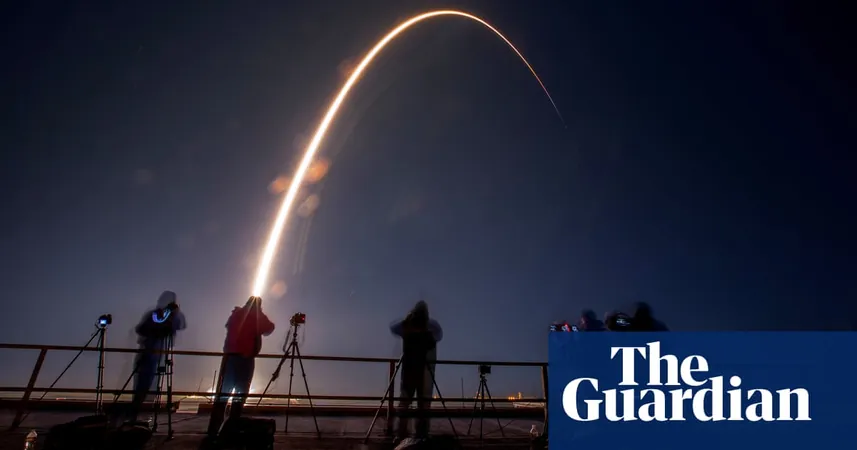
SpaceX Successfully Launches Dual Lunar Lander Mission: A New Era for Moon Exploration!
2025-01-15
Author: Ying
SpaceX Launches Two Lunar Landers
Early Wednesday morning, two ambitious lunar landers embarked on their journey to the moon, following a successful launch aboard a SpaceX Falcon rocket from Florida's Kennedy Space Center. This groundbreaking mission marks a significant step for private space endeavors, with Texas-based Firefly Aerospace and Japan’s ispace teaming up to share the lift-off.
Details of the Launch
The launch occurred at 1:11 am ET, propelling a rover named "Resilience," built by Tokyo's ispace, alongside Firefly Aerospace's "Blue Ghost Mission 1." This ambitious mission aims to conduct important experiments for NASA upon landing, which is expected in early March. After separating from the Falcon rocket an hour into its flight, each lander will navigate independently towards lunar orbit. The expected timeline has Blue Ghost set for an earlier landing, while Resilience is scheduled to arrive around late May or early June.
A Chance for Redemption
For ispace, this mission is a chance to redeem its aspirations after a previous attempt in April 2023 ended in heartbreak when its first private moon landing resulted in a crash. The Resilience rover will work to collect lunar dust samples and investigate potential sources of water and food, vital for future human exploration, as it undertakes a series of deliberate explorations from its landing site at Mare Frigoris, situated in the moon’s frigid north.
Successful Communication and Power Generation
In a fascinating update from ispace management, they confirmed the establishment of a reliable communication link with the Resilience lander and reported a stable generation of electrical power as it orbits the moon. The objectives for the Blue Ghost lander mirror those of its Japanese counterpart, helping to pave the way for NASA’s Artemis III mission, which aims for a crewed return to the lunar surface in mid-2027—marking the first such event since the last Apollo mission in 1972!
NASA's Investment and Goals
NASA has invested $145 million into Firefly's mission, encompassing not only the lander but also ten investigative experiments including measures of lunar temperature by drilling below the surface, and developing technology to keep astronauts and their equipment free of abrasive lunar dust.
Exploring Unique Lunar Phenomena
As the two missions progress, Firefly aims to examine unique lunar phenomena. Jason Kim, CEO of Firefly, expressed enthusiasm about capturing high-definition imagery of a breathtaking solar eclipse viewed from the moon, where Earth obstructs the sun. This "lunar sunset" is anticipated to yield high-value data surrounding how lunar regolith reacts under dusk conditions, with echoes of the observations made by Apollo 17 astronaut Eugene Cernan.
A New Era of Collaboration
The partnership between NASA and Firefly encompasses broader goals of integrating commercial spaceflight into lunar exploration, a domain previously dominated by government entities. By creating platforms for private aerospace innovations, NASA's Artemis program is set to showcase collaboration between public and private sectors.
Looking Ahead to Future Missions
Looking ahead, next month plans to see Texas-based Intuitive Machines embark on its second lunar mission under contract, returning to the moon with groundbreaking equipment designed to explore water resources and deploy a novel Micro-Nova hopper that can conduct experiments in shaded areas.
A Promising Future for Lunar Exploration
With only five nations having successfully landed spacecraft on the moon since the 1960s— the United States, China, India, Japan, and the former Soviet Union— the recent launches signal a promising future where private companies play a pivotal role in exploring our celestial neighbor. Stay tuned as we witness this exciting chapter in space exploration unfold!





 Brasil (PT)
Brasil (PT)
 Canada (EN)
Canada (EN)
 Chile (ES)
Chile (ES)
 Česko (CS)
Česko (CS)
 대한민국 (KO)
대한민국 (KO)
 España (ES)
España (ES)
 France (FR)
France (FR)
 Hong Kong (EN)
Hong Kong (EN)
 Italia (IT)
Italia (IT)
 日本 (JA)
日本 (JA)
 Magyarország (HU)
Magyarország (HU)
 Norge (NO)
Norge (NO)
 Polska (PL)
Polska (PL)
 Schweiz (DE)
Schweiz (DE)
 Singapore (EN)
Singapore (EN)
 Sverige (SV)
Sverige (SV)
 Suomi (FI)
Suomi (FI)
 Türkiye (TR)
Türkiye (TR)
 الإمارات العربية المتحدة (AR)
الإمارات العربية المتحدة (AR)